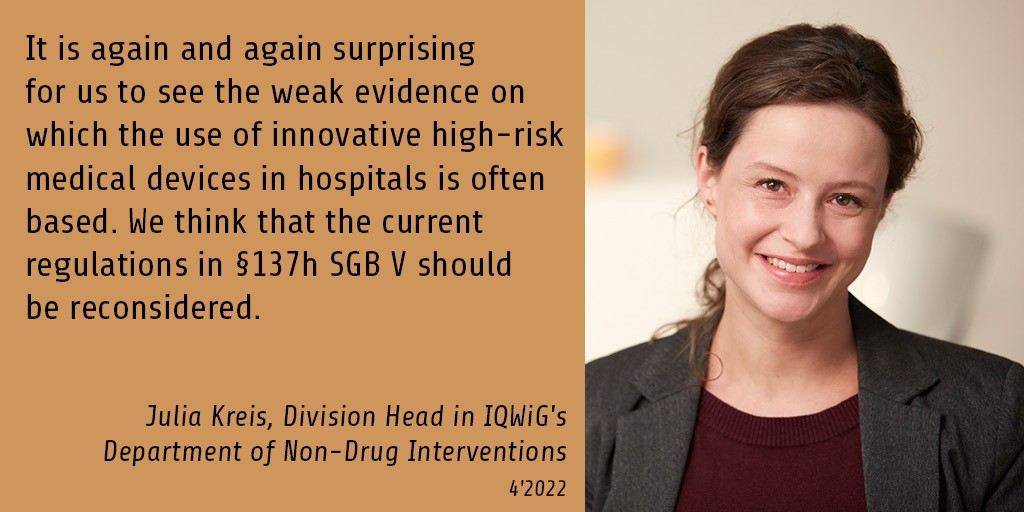Mar 28, 2022
High-risk medical devices: No comparative data available for two new methods
IQWiG assessed one new invasive procedure each for the treatment of pancreatic tumours and uterine fibroids. Due to a lack of robust data, the Institute outlined testing studies for both methods.
When assessing new examination and treatment methods involving high-risk medical devices in accordance with §137h of the German Social Code, Book V (SGB V), the Institute for Quality and Efficiency in Health Care (IQWiG) examines the data submitted by the hospital and the manufacturer. If a benefit of the new invasive (and particularly expensive) method can be inferred from these data, it may continue to be used. If it is shown that the new procedure is ineffective or even harmful for those treated, it is excluded from health care. If it is not possible to make a reliable conclusion on benefit, harm or ineffectiveness, the Federal Joint Committee (G-BA) is required by law to set up and also fund a testing study. IQWiG usually has only six weeks to assess methods involving high-risk medical devices.
IQWiG has now published its assessment for two 137h procedures commissioned by the G-BA: “endoscopic ultrasound-guided 32P microparticle implantation for unresectable, locally advanced pancreatic tumours” and “transcervical radiofrequency ablation with intrauterine ultrasound guidance for uterine fibroids”. For both methods, neither benefit nor harm nor ineffectiveness can be determined on the basis of the documents submitted.
³²P-labeled microparticles for pancreatic cancer
With this method, patients with surgically unresectable, locally advanced tumours in the pancreas are injected with radioactive microparticles directly into the malignant tissue using a puncture needle. The invasive procedure is intended to be used in addition to first-line chemotherapy and to help reduce the size of the tumour so that it can potentially be completely removed surgically.
For the assessment of the method, the hospital and the manufacturer had submitted a total of six studies, all with results on relatively few patients and completely without (or without a suitable) control group. On the basis of these documents, no robust conclusions on benefit or harm could be inferred.
In order to be able to demonstrate an advantage for the method “implantation via injection under endoscopic ultrasound guidance of ³²P-labeled microparticles” in the composite outcome of treatment failure, in IQWiG’s opinion a medium-sized randomized controlled trial (RCT) should be set up to compare this new method with first-line chemotherapy or (chemo)radiotherapy alone.
Transcervical radiofrequency ablation for uterine fibroids
With this method, benign tumours of the muscular uterine wall are localized by ultrasound probe and obliterated (ablated) by radiofrequency energy. This is to relieve heavy bleeding and pain associated with symptomatic uterine fibroids.
IQWiG had results from five case series for the assessment of this method. In addition, the hospital and the manufacturer referred to an RCT in the planning stage. On the basis of the documents submitted, no conclusions on benefit, ineffectiveness or harm could be inferred.
In order to gain the necessary knowledge on the potential benefit of transcervical radiofrequency ablation with intrauterine ultrasound guidance (TRFA) for uterine fibroids, IQWiG considers two medium-sized testing studies to be necessary. This is because different control interventions are relevant, depending on the location of the fibroids: for women with fibroids at the outer edge or in the middle of the muscular uterine wall, a comparison with surgical removal of the fibroids via laparoscopy (laparoscopic myomectomy or enucleation) would be relevant. If, in contrast, the fibroids are located only at the inner edge of the uterine muscle directly below the endometrium (submucosal), hysteroscopic myomectomy (surgical removal via the vagina and uterus) would be an important control treatment. A second study would be useful for this purpose.
Legal framework makes testing studies difficult in some cases
Since it is not possible to draw any reliable conclusion on the benefits, harms or ineffectiveness of the two new high-risk methods on the basis of the documents submitted, the law obliges the G-BA to set up and also fund testing studies.
Julia Kreis, Division Head in IQWiG's Department of Non-Drug Interventions, critically notes that “in this context, the recruitment of study participants for such studies is made more difficult for the G-BA by the fact that the new treatment methods are also available outside of testing studies as a service provided by statutory health insurance. This is because precisely those hospitals that have introduced a new method obviously want to use it in routine practice and in some cases are already advertising it. Many eligible patients then do not participate in the study, but directly receive the new treatment method already commonly used in the hospital in question. It is again and again surprising for us to see the weak evidence on which the use of innovative high-risk medical devices in hospitals is often based. We think that the current regulations in §137h SGB V should be reconsidered.”
An extract of the final report will be soon be published in English. If you would like to be informed when it is published, please contact info@iqwig.de.


